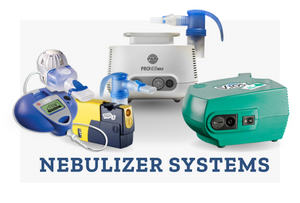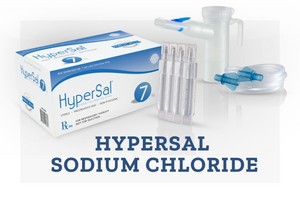
How to Use a Vortex Spacer to Improve Asthma Inhaler Therapy
 Enhance Asthma Inhaler Therapy With Vortex Holding Chambers
Enhance Asthma Inhaler Therapy With Vortex Holding Chambers
For those with asthma, managing symptoms requires the right medication and effective delivery of that medication to the lungs. Using a spacer with inhaler therapy can significantly improve medication delivery to the lungs, helping to achieve better symptom control. A spacer or holding chamber helps ensure that asthma medications, delivered by a metered dose inhaler are used correctly.
If you’ve struggled with inhaler use or want better control over your asthma, adding an inhaler spacer to your routine could be the solution. Let’s break down what spacers are, their benefits, and why options like the PARI Vortex Non-Electrostatic Holding Chamber are ideal for improving asthma therapy.
Understanding Asthma & The Importance of Proper Inhaler Techniques
What is Asthma?
Asthma is a chronic condition that affects the airways, causing inflammation and narrowing that makes breathing difficult. Triggers like allergens, exercise, and respiratory infections can lead to wheezing, coughing, and shortness of breath.
Managing asthma usually involves using a metered dose inhaler to deliver medications directly to the lungs. To ensure that these medications are effective, proper inhaler techniques are essential
How Technique Affects Asthma Medication Delivery
Using the correct inhaler technique is essential for effective asthma management. Inhalers release medication as a fine spray that must be inhaled deeply to reach the lungs. Without a spacer, much of the medication may get stuck in the mouth or throat instead of reaching the airways where it’s needed. A spacer is specifically designed for metered-dose inhalers (MDIs) and should not be used with dry powder inhalers (DPIs), as DPIs require a different inhalation technique to be effective.
Using an inhaler with a holding chamber allows the medication to remain suspended in the chamber, making it easier to inhale and improving delivery to the lungs, by reducing the need for a specific inhalation technique.. This not only improves asthma control but also reduces side effects like oral thrush and throat irritation.
What Are Spacers & Holding Chambers?
What is a Spacer?
The term spacer and holding chamber are often used interchangeably, but there is a subtle difference. A spacer is a device designed to enhance medication delivery for MDIs. It typically has a tube-like structure that connects to the mouthpiece of your inhaler. When you press down on the inhaler, it helps slow down the speed of the medication particles making them easier to inhale and reduce how much medication hits the back of the mouth and throat.
 What is a Holding Chamber?
What is a Holding Chamber?
A holding chamber functions as an advanced type of spacer that incorporates a one-way valve mechanism specifically designed to enhance the delivery of medication. This unique design is crucial because it allows
the medication to remain in the chamber temporarily until it is needed, holding chambers can significantly improve the effectiveness of the medication delivered through metered-dose inhalers (MDIs). It also helps coordinate inhalation with medication release, making it especially beneficial for children, the elderly, or anyone with difficulty timing their breaths.
Discover more about holding chambers for MDIs and find the best options available.
Why Use a Spacer or Holding Chamber?
Whether you’re using a spacer inhaler or a holding chamber, both improve medication delivery to the lungs. They also make inhaler use easier, especially for children or older adults who may have difficulty coordinating their breath with the inhaler spray. By reducing the need for precise timing, these devices ensure that more medication reaches the lungs.
Benefits of Using a Spacer or Holding Chamber
Using a spacer for adults or kids offers many advantages. Here are some key benefits:
1. Better Delivery of Medication
Without a spacer or holding chamber, medication often settles in the throat or mouth instead of the lungs. By keeping the aerosolized medication in place, holding chambers help more of it reach the airways, helping to make treatments more effective and improve asthma control. This leads to better symptom management and more consistent treatment outcomes.
2. Easier to Use
Coordinating your breath with the inhaler spray can be tricky, especially for younger children or seniors. A holding chamber inhaler simplifies the process by holding the medication in place until it’s inhaled.
Spacers and holding chambers for children often include masks that make inhalation stress-free. This ease of use ensures a more reliable and stress-free experience for both patients and caregivers.
3. Reduced Side Effects
Because more medication is delivered to the lungs, less settles in the mouth and throat. This helps reduce side effects like:
-
Oral thrush (a fungal infection in the mouth)
-
Hoarseness or voice changes
-
Dryness or irritation
4. Suitable for All Ages
Spacers for inhalers aren’t just for children—they’re also ideal for adults and seniors. The PARI Vortex is a widely recommended holding chamber for adults but is also a top choice for users of all ages.
 Why Choose the PARI Vortex Holding Chamber?
Why Choose the PARI Vortex Holding Chamber?
The PARI Vortex Non-Electrostatic Holding Chamber is a highly recommended option for anyone looking to improve asthma therapy. Its advanced design and versatility make it suitable for users of all ages, ensuring better results with every use.
Key Features of the PARI Vortex:
-
Non-Electrostatic Technology
Standard spacers made from plastic often attract medication particles to their walls, reducing the dose that reaches the lungs. The PARI Vortex eliminates this problem with its non-electrostatic design, ensuring more medication is delivered where it’s needed. This feature makes it a superior choice for consistent and effective asthma medication delivery. -
Compatibility
The Vortex is compatible with most metered dose inhalers, making it a flexible option for different asthma medications. This versatility ensures that users won’t need to switch devices when changing or updating their inhalers. -
Kid-Friendly Options
For families, the PARI Vortex is also available with mask attachments, making it an excellent holding chamber for kids who may find mouthpieces difficult to use. The mask option can help children feel more at ease with inhaler use, supporting ease of administration during treatment. -
Durability and Easy Maintenance
Built to last, the Vortex is durable and easy to clean, which ensures reliable performance over time. Its simple maintenance requirements make it a convenient option for busy households or frequent users.
How to Use an Inhaler with a Spacer or Holding Chamber
Using a metered dose inhaler with a spacer is simple. Follow these steps to get the most out of your device:
-
Prepare Your Inhaler
Start by shaking your inhaler well to mix the medication thoroughly. If your inhaler is new or hasn’t been used in a while, you may need to prime it by spraying a few test puffs into the air (check the specific instructions for your inhaler). -
Attach the Spacer
Securely connect the spacer to the inhaler's mouthpiece. For children or users who struggle with a standard mouthpiece, consider using a spacer with a mask attachment to make the process easier and more effective. Double-check that the spacer is fitted tightly to prevent medication from leaking out. -
Release the Medication
Hold the inhaler and spacer upright, and press down firmly on the inhaler to release a puff of medication into the spacer. Make sure the spacer is positioned correctly and doesn’t tip over, as this could affect the medication's release, -
Inhale Slowly
Place the mouthpiece (or mask, if using one) securely over your mouth. Take a slow, deep breath through the spacer to draw the medication into your lungs.
-
Hold Your Breath
Once you’ve inhaled, hold your breath for about 10 seconds or as long as you comfortably can. This gives the medication time to settle in your airways and deposit into your lungs.
-
Repeat if Necessary
If your doctor has prescribed more than one puff, wait about 30 seconds before repeating the steps. Shake the inhaler again between each puff to ensure an accurate dose is delivered each time.
To keep your spacer functioning properly and maintain hygiene, clean it at least once a week. Rinse it in warm, soapy water, then rinse thoroughly with clean water to remove any residue. Allow the spacer to air dry completely before using it again. Avoid using a cloth or towel to dry it, as this could introduce lint or fibers.
Take Control of Your Asthma with the Right Spacer
Adding a spacer or holding chamber to your inhaler routine is a simple yet effective way to improve your asthma therapy. From reducing side effects to ensuring better
medication delivery, devices like the PARI Vortex Non-Electrostatic Holding Chamber make a big difference.
Looking for where to buy inhaler spacers? Visit Nebology’s collection of spacers and holding chambers today to find the best option for your needs.
Frequently Asked Questions (FAQs)
Do I need a prescription for a spacer?
Holding chambers such as the PARI VORTEX are medical devices that require a prescription. Purchasing through online retailers like Nebology can help guide you through this process.
Can I use a spacer with any inhaler?
Spacers are specifically designed for metered dose inhalers (MDIs), the most common type of inhaler used for asthma management. While most spacers, including the PARI Vortex, are compatible with a wide range of inhalers, it’s always a good idea to check compatibility before purchasing.
How often should I clean my spacer?
Clean your spacer at least once a week to maintain hygiene and ensure optimal performance. Wash it in warm, soapy water, gently rinsing it to remove any residue.
After cleaning, let it air dry completely before using it again. For detailed instructions, check the cleaning guidelines provided by your spacer's manufacturer.
What makes non-electrostatic chambers more efficient than plastic chambers?
Non-electrostatic technology, like that in the PARI Vortex, prevents medication from sticking to the walls of the spacer, ensuring a more efficient dose is delivered to the lungs. Standard plastic spacers can develop a static charge that causes medication to cling to the surface, reducing the amount delivered to the lungs. Non-electrostatic chambers address this issue, ensuring more consistent and efficient medication delivery.


